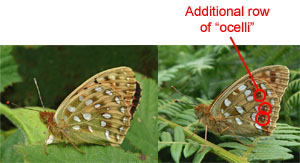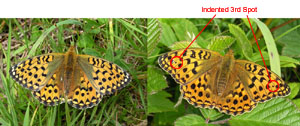I am gradually filling in the gaps in my UK butterfly collection. On Monday I detoured to Collard Hill on a return journey from Wales. I didn't get there until about four thirty so did not have long to search for the Large Blue but I did get to see one. The record shot is really awful so I am not putting it up here but I was just happy to have seen it.
Today was a trip down to Aish Tor on Dartmoor in search of the High Brown Fritillary. A long day, seven hours of driving and about seven hours searching for butterflies, but at least the driving was shared with Dave. More importantly we did get to see the target butterfly.
It was hot and the butterflies were very active so finding one that would stay still long enough to get a picture was difficult. We also had the problem that the Dark Green Fritillary flies at the same site and from a top view they are difficult to tell apart. However if you can get a view of the underwing it is easy tell the difference between the two. I was going to try to explain this but in the end decided to lift this explanation from the UK Butterflies site.
The Dark Green Fritillary and High Brown Fritillary are most easily distinguished by their undersides, since only the High Brown Fritillary has a row of "ocelli" just inside the outer margin. In addition, as the name suggests, the High Brown Fritillary has a predominately brown hue to the underside, whereas the Dark Green Fritillary is predominately green.
 |
Dark Green Fritillary (left) and High Brown Fritillary
(right)
|
It is much more difficult to distinguish the Dark Green
Fritillary from the High Brown Fritillary based on their uppersides. However,
the first row of dots from the outside edge of the forewing upperside do give a
clue - the 3rd dot from the apex of the forewing is in line with the other dots
in the Dark Green Fritillary, but indented toward the body in the High Brown
Fritillary.
 |
Dark Green Fritillary (left) and High Brown Fritillary
(right)
|
Armed with these sort of details we expected to be able to identify the High Browns easily. In practice the butterflies were so active that we struggled to even get shots of the upper wings. Still, here we go , starting with the easy bit first.
 |
| Dark Green Fritillary - no ocelli showing |
 |
| High Brown Fritillary - with additional row of ocelli |
 |
| High Brown Fritillary - but not showing much of an indent on upperwing spot three |
 |
| Dark Green Fritillary - no indent towards body on spot three |
 |
| High Brown Fritillary - showing third spot indented |
 |
| High Brown Fritillary |
The High Browns are also supposed to show a slightly concave outside edge to their forewing whilst the Dark Green has a more rounded profile. You can see this on some specimens but on others and dependant on the camera angle it gets more confusing.
 |
| High Brown ? |
You then have the problem of individual variations. This last picture looks like a High Brown but I did not see the under wing and cannot be sure. I also wondered about hybrids between the two species but cannot find any references to these on the web. If you want to be one hundred percent sure you really need to see the underside.
There were also some tatty specimens of Small Pearl-bordered Fritillaries flying and lots of Green Hairstreaks.
 |
| Green Hairstreak |
A few Painted Ladies looking very worn but perhaps the start of a big influx.
 |
| Painted Lady |
and a single Golden-ringed Dragonfly
 |
| Golden-ringed Dragonfly |
It was a long way to go but it was a great day out. I am going to need one or two trips to Scotland to finish off the set.
No comments:
Post a Comment